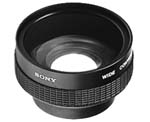Dream
Sequence 4
Phase two: My gear
At the time, there was no choice as to which camera I would be using. The venerable Sony VX1000 was king of the DV hill, and there are still people today who shoot with nothing else. It was an amazing leap of technology when it first appeared more than five years ago, and it was perfectly suited to shoot this kind of documentary. Rugged, reliable, and quickly configurable to a wide variety of shooting conditions, my VX1000 could be out of its bag, turned on, and focused within a few seconds. Having used it extensively for many, many hours before taking on this project, I knew I could walk into a room, look at the available light, figure out the kind of shot I wanted, and know exactly how to get it while the energy of the scene was still happening. There was no other camera at the time that could deliver the blend of picture quality and responsiveness that I felt was absolutely necessary. There are no second takes for reality, and that was what I was going for. I bought the camera in February of 1997 for about $3400.
Screwed to the front of the camera was a Sony wide-angle adapter lens (VCL-0752H), which cost about $180. I put it on and never took it off again. My style of shooting involves getting as close to the subject as possible, but I also like to give some context to each shot. The wide lens gave me the intimacy I wanted without sacrificing my ability to place the subject in an environment. Although the wide gives a slight "fisheye" distortion, I found I could minimize it and get a more interesting composition by framing someone to one side of the shot and letting the background occupy more of the center, whenever possible. One thing the adapter desperately needed was a lens shade, but Sony didn't make one for that lens, or even provide threads on the front for one. So I cut the rubber section off a 72mm Tiffen shade made for a large professional lens and gaffer-taped it to the front of the camera, which gave it a funky-pro look. Sort of a digital bazooka. People who know about cameras would come up to me and say, "What is that thing?"
Because I was determined not to artificially light anything any more than absolutely necessary, my lighting kit consisted of a three-foot-in-diameter collapsible reflector, which I could usually get someone to hold, and a cheap, on-camera, battery-powered light. I think I paid about $50 for it at a consumer-electronics shop and paid an additional $50 for a strong battery and charger. It proved invaluable. It gave me just enough light to "kick" a dark scene, without overpowering it and making it look unnatural. If I were going to be up close to someone, I would carefully tape a piece of tracing paper to a small wire armature I had constructed to hang a bit in front of the light, to soften its effect so my subjects wouldn't squint. Lighting is a huge world, with many portable and not-so-portable solutions. Good lighting is an art, as is working with existing light, which is more the specialty of most in-the-field (or in-the-desert) documentarians.
Next >>
|

